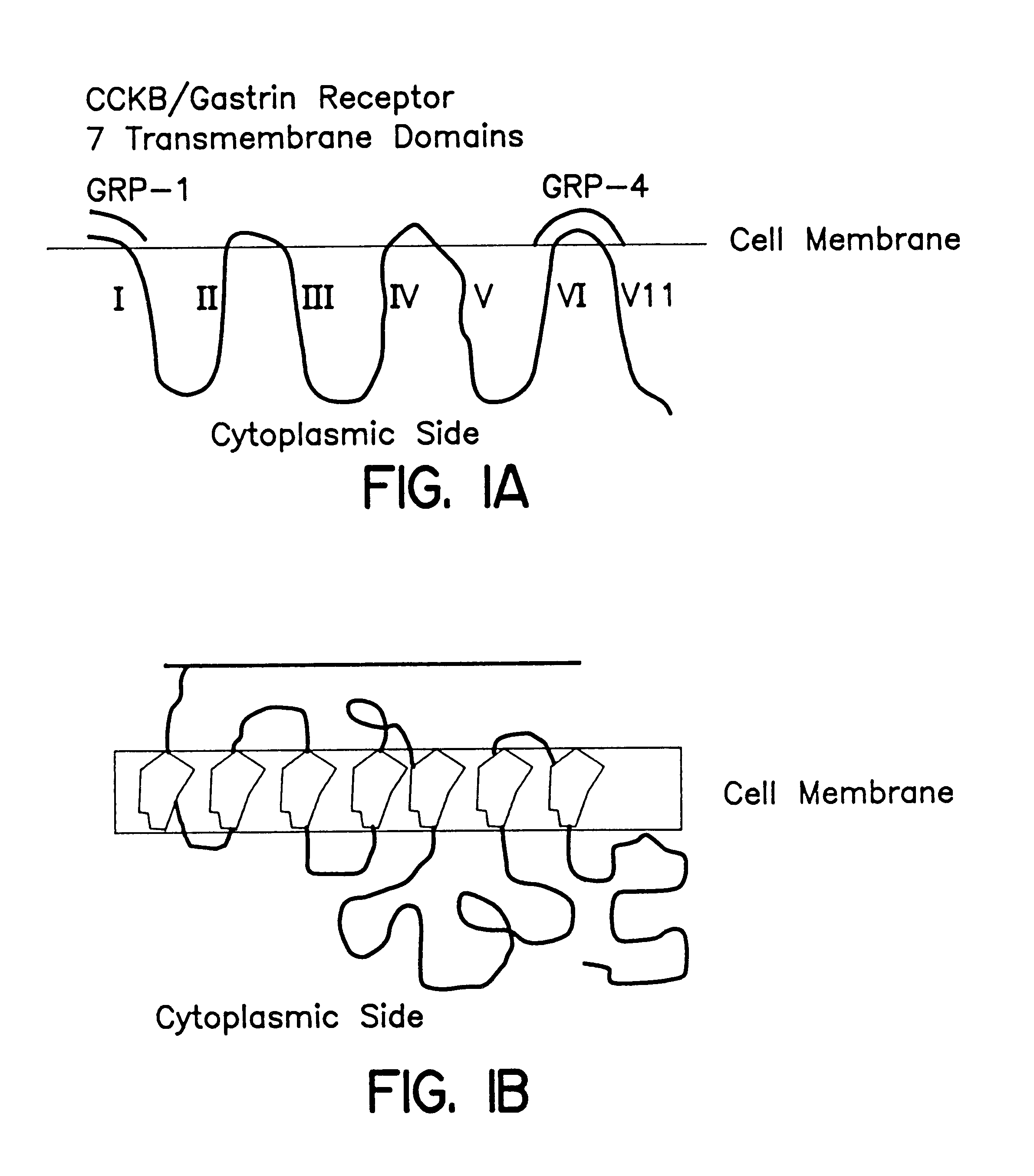Immunogenic compositions to the CCK-B/gastrin receptor and methods for the treatment of tumors
a technology of cckb/gastrin receptor and composition, which is applied in the direction of gastrin/cholecystokinin, drug composition, peptide, etc., can solve the problems of lack of specificity, severe toxic side effects of antagonists, lack of potency, etc., and achieve the effect of inhibiting the autocrine growth-stimulatory pathway and effectively preventing the binding of peptide hormones to receptors
- Summary
- Abstract
- Description
- Claims
- Application Information
AI Technical Summary
Benefits of technology
Problems solved by technology
Method used
Image
Examples
example 1
Preparation of GRP1-DT and GRP4-DT Conjugates
CCK-B / gastrin-receptor peptides were prepared by standard solid state peptide synthesis. To make immunogens capable of inducing specific immune responses each of Peptide 1 and 4 was synthesized containing the spacer sequence SSPPPPC (SEQ ID NO.:3 in the Sequence Listing) at its carboxy terminus. These peptides were subsequently conjugated to amino groups present on the carrier, Diphtheria toxoid ("DT"), via the terminal peptide amino acid residue cysteine of the spacer utilizing a heterobifunctional linking agent containing a succinimidyl ester at one end and maleimide at the other end of the linking agent by either of Method A or Method B as described below.
Method A: As previously described in U.S. Pat. No. 5,023,077, the linking of Peptide 1 or 4 above and the carrier is accomplished as follows. Dry peptide was dissolved in 0.1 M Sodium Phosphate Buffer, pH 8.0, with a thirty-fold molar excess of dithiothreitol ("DTT"). The solution was...
example 2
The following experiments were performed to establish the specificity of antibodies raised in rabbits against the GRP1-DT peptide containing Ser spacer described Example 1 using Method B. A series of tests were conducted to assess the specificity of rabbit antibodies induced by immunization with the GRP1-DT and affinity purified by immunoadsorption over a GRP1-Ser Sepharose column.
An inhibition ELISA was used to assess the specificity of the affinity purified antibodies for GRP1-Ser peptide. The assays were run as follows: GRP1-Ser-BSA conjugate was coated onto 96 well plates (Immulon U bottom) by overnight incubation of 50 .mu.l of a 2 .mu.g / ml solution of conjugate in glycine buffer (0.1M, pH=9.5) at 4.degree. C. Affinity purified anti-GRP1 Ab (at a final concentration of 10 ng / ml) was combined with various inhibitors (in 1:10 dilution series) and incubated for 1 hour at room temperature. The inhibitors included GRP1-Ser, GRP1 EPT, Ser, human gastrin 17(1-9)-Ser spacer (hG17(9)-Se...
example 3
AR42J tumor cells (European Collection of Animal Cell cultures, Porton Down, UK) are derived from a rat pancreatic adenocarcinoma and are known to have well characterized CCK-B / gastrin-receptors. Thus AR42J were tested to confirm the expression of CCK-B / gastrin-receptor and specificity of the receptor for hH17 by radioligand inhibition. AR42J cells were cultured at 37.degree. C. with 7% CO.sub.2 in complete RPMI 1640 (Sigma) supplemented with 10% FCS (Gemini Bioproducts), 2 mM glutamine (JRH Biosciences), 1 mM sodium pyruvate (JRH B.) and 50 .mu.g / ml gentamicin (Gemini Bioproducts). The cells were harvested from 175 cm.sup.2 T-flasks (Falcon Plastics) with PBS containing 0.25% EDTA, then washed twice with PBS (no EDTA) by centrifugation (400.times.g for 10 min). The cells were kept at 0-4.degree. C. for all manipulations. A single cell suspension was prepared in buffer, and the cell concentration was adjusted to 10.sup.6 cells / ml. Aliquots of 1 ml of cell suspension were added to 12...
PUM
| Property | Measurement | Unit |
|---|---|---|
| Composition | aaaaa | aaaaa |
| Immunogenicity | aaaaa | aaaaa |
Abstract
Description
Claims
Application Information
 Login to View More
Login to View More - R&D
- Intellectual Property
- Life Sciences
- Materials
- Tech Scout
- Unparalleled Data Quality
- Higher Quality Content
- 60% Fewer Hallucinations
Browse by: Latest US Patents, China's latest patents, Technical Efficacy Thesaurus, Application Domain, Technology Topic, Popular Technical Reports.
© 2025 PatSnap. All rights reserved.Legal|Privacy policy|Modern Slavery Act Transparency Statement|Sitemap|About US| Contact US: help@patsnap.com



